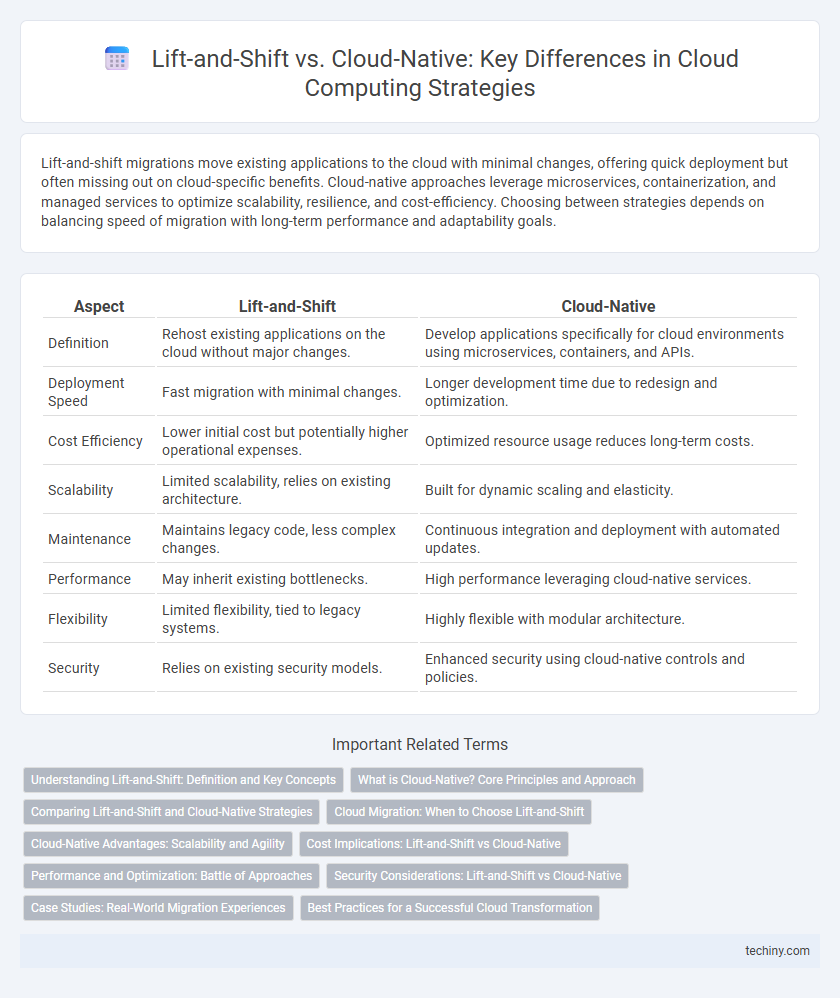Lift-and-shift migrations move existing applications to the cloud with minimal changes, offering quick deployment but often missing out on cloud-specific benefits. Cloud-native approaches leverage microservices, containerization, and managed services to optimize scalability, resilience, and cost-efficiency. Choosing between strategies depends on balancing speed of migration with long-term performance and adaptability goals.
Table of Comparison
| Aspect | Lift-and-Shift | Cloud-Native |
|---|---|---|
| Definition | Rehost existing applications on the cloud without major changes. | Develop applications specifically for cloud environments using microservices, containers, and APIs. |
| Deployment Speed | Fast migration with minimal changes. | Longer development time due to redesign and optimization. |
| Cost Efficiency | Lower initial cost but potentially higher operational expenses. | Optimized resource usage reduces long-term costs. |
| Scalability | Limited scalability, relies on existing architecture. | Built for dynamic scaling and elasticity. |
| Maintenance | Maintains legacy code, less complex changes. | Continuous integration and deployment with automated updates. |
| Performance | May inherit existing bottlenecks. | High performance leveraging cloud-native services. |
| Flexibility | Limited flexibility, tied to legacy systems. | Highly flexible with modular architecture. |
| Security | Relies on existing security models. | Enhanced security using cloud-native controls and policies. |
Understanding Lift-and-Shift: Definition and Key Concepts
Lift-and-shift is a cloud migration strategy that involves moving existing applications and workloads from on-premises infrastructure to the cloud without redesigning or re-architecting them. This approach prioritizes speed and cost-efficiency by replicating the current environment in cloud infrastructure, maintaining application compatibility with minimal changes. Key concepts include infrastructure as a service (IaaS), minimal refactoring, and quick migration timelines, making it ideal for organizations seeking a straightforward transition to cloud computing.
What is Cloud-Native? Core Principles and Approach
Cloud-native architecture leverages containerization, microservices, and dynamic orchestration to build scalable and resilient applications directly on cloud platforms. Core principles include designing for failure, continuous integration and delivery (CI/CD), and infrastructure as code (IaC) to optimize resource utilization and accelerate development cycles. This approach contrasts with lift-and-shift by re-architecting applications to fully exploit cloud scalability, automation, and flexibility.
Comparing Lift-and-Shift and Cloud-Native Strategies
Lift-and-shift strategy involves migrating existing applications to the cloud with minimal changes, prioritizing speed and cost-efficiency but often missing cloud optimization benefits. Cloud-native approach designs applications specifically for cloud environments, leveraging microservices, containers, and serverless computing to enhance scalability, resilience, and agility. Organizations aiming for long-term innovation and operational efficiency prefer cloud-native development despite higher initial complexity compared to lift-and-shift migrations.
Cloud Migration: When to Choose Lift-and-Shift
Lift-and-shift migration is ideal for organizations seeking rapid cloud adoption without extensive application redesign, preserving existing architecture while reducing upfront costs. This approach suits legacy systems with minimal modification needs, enabling quick deployment on cloud infrastructure to improve scalability and disaster recovery. Choosing lift-and-shift accelerates cloud migration timelines and leverages cloud benefits while deferring modernization to a later phase.
Cloud-Native Advantages: Scalability and Agility
Cloud-native architectures leverage microservices and containerization, enabling seamless scalability by dynamically adjusting resources based on demand. This approach enhances agility, allowing rapid development, deployment, and continuous integration/continuous delivery (CI/CD) workflows. Embracing cloud-native principles maximizes the benefits of cloud environments, driving operational efficiency and accelerated innovation.
Cost Implications: Lift-and-Shift vs Cloud-Native
Lift-and-shift migration typically incurs lower initial costs by replicating existing workloads on cloud infrastructure without redesigning applications, but it can lead to higher ongoing operational expenses due to inefficient resource use. Cloud-native approaches may have higher upfront development and refactoring investments, yet they optimize cost over time by leveraging auto-scaling, microservices, and managed cloud services that improve resource efficiency. Organizations must analyze total cost of ownership (TCO), balancing immediate migration savings against long-term operational savings inherent in cloud-native architectures.
Performance and Optimization: Battle of Approaches
Lift-and-shift migrations replicate on-premises workloads in the cloud with minimal changes, often resulting in suboptimal performance due to legacy architecture constraints. Cloud-native applications leverage microservices, containers, and serverless technologies to optimize resource utilization, scalability, and response times directly in the cloud environment. This contrast highlights how cloud-native designs significantly enhance performance by harnessing auto-scaling and tailored infrastructure, while lift-and-shift may incur higher latency and increased operational costs.
Security Considerations: Lift-and-Shift vs Cloud-Native
Lift-and-shift migration often inherits existing on-premises security vulnerabilities due to limited optimization for cloud-native controls, posing risks such as misconfigured access and inadequate threat detection. Cloud-native approaches leverage built-in security features like identity and access management (IAM), micro-segmentation, and automated compliance monitoring, enhancing protection against advanced threats. Prioritizing cloud-native security frameworks reduces attack surfaces and improves resilience through continuous monitoring and orchestration aligned with cloud service provider best practices.
Case Studies: Real-World Migration Experiences
Case studies reveal that lift-and-shift migrations enable rapid cloud adoption by directly moving applications with minimal changes, often reducing upfront costs and downtime for enterprises like Capital One and GE Healthcare. Cloud-native approaches, exemplified by Netflix and Spotify, leverage microservices and containerization to optimize scalability, performance, and resilience, driving long-term innovation and operational efficiency. Comparative analyses highlight that while lift-and-shift suits legacy system migration with immediate benefits, cloud-native development aligns better with future-proofing and exploiting full cloud capabilities.
Best Practices for a Successful Cloud Transformation
Lift-and-shift migration accelerates cloud adoption by moving existing applications without redesign, but cloud-native development unlocks full scalability and cost-efficiency through microservices and containerization. Best practices for successful cloud transformation include thorough workload assessment, adopting automation and DevOps methodologies, and aligning cloud architecture with business objectives. Emphasizing security, governance, and continuous optimization ensures resilience and maximizes cloud investments.
Lift-and-Shift vs Cloud-Native Infographic

 techiny.com
techiny.com